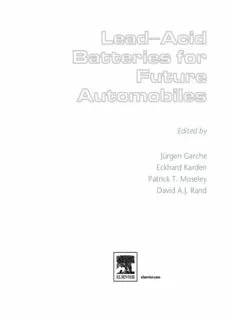
Lead-Acid Batteries for Future Automobiles PDF
Preview Lead-Acid Batteries for Future Automobiles
LeadeAcid Batteries for Future Automobiles Edited by Ju¨rgen Garche Eckhard Karden Patrick T. Moseley David A.J. Rand Elsevier Radarweg29,POBox211,1000AEAmsterdam,Netherlands TheBoulevard,LangfordLane,Kidlington,OxfordOX51GB,UnitedKingdom 50HampshireStreet,5thFloor,Cambridge,MA02139,UnitedStates Copyright©2017ElsevierB.V.Allrightsreserved. Nopartofthispublicationmaybereproducedortransmittedinanyformorbyany means,electronicormechanical,includingphotocopying,recording,orany informationstorageandretrievalsystem,withoutpermissioninwritingfromthe publisher.Detailsonhowtoseekpermission,furtherinformationaboutthe Publisher’spermissionspoliciesandourarrangementswithorganizationssuchasthe CopyrightClearanceCenterandtheCopyrightLicensingAgency,canbefoundatour website:www.elsevier.com/permissions. Thisbookandtheindividualcontributionscontainedinitareprotectedunder copyrightbythePublisher(otherthanasmaybenotedherein). Notices Knowledgeandbestpracticeinthisfieldareconstantlychanging.Asnewresearch andexperiencebroadenourunderstanding,changesinresearchmethods, professionalpractices,ormedicaltreatmentmaybecomenecessary. Practitionersandresearchersmustalwaysrelyontheirownexperienceand knowledgeinevaluatingandusinganyinformation,methods,compounds,or experimentsdescribedherein.Inusingsuchinformationormethodstheyshouldbe mindfuloftheirownsafetyandthesafetyofothers,includingpartiesforwhomthey haveaprofessionalresponsibility. Tothefullestextentofthelaw,neitherthePublishernortheauthors,contributors, oreditors,assumeanyliabilityforanyinjuryand/ordamagetopersonsorpropertyas amatterofproductsliability,negligenceorotherwise,orfromanyuseoroperation ofanymethods,products,instructions,orideascontainedinthematerialherein. LibraryofCongressCataloging-in-PublicationData AcatalogrecordforthisbookisavailablefromtheLibraryofCongress BritishLibraryCataloguing-in-PublicationData AcataloguerecordforthisbookisavailablefromtheBritishLibrary ISBN:978-0-444-63700-0 ForinformationonallElsevierpublicationsvisitour websiteathttps://www.elsevier.com/books-and-journals Publisher:JohnFedor AcquisitionEditor:KostasMariniakis EditorialProjectManager:ChristineMcElvenny ProductionProjectManager:VijayarajPurushothaman Designer:MatthewLimbert TypesetbyTNQBooksandJournals List of Contributors J. Albers JohnsonControlsAutobatterieGmbH&Co.KGaA,Hannover,Germany J. Badeda RWTHAachenUniversity,Aachen,Germany Ju¨lichAachenResearchAlliance,Ju¨lich,Germany IRWTHAachenUniversity,Aachen,Germany M. Bremmer RobertBoschGmbH,Leonberg,Germany C. Chumchal Ford-WerkeGmbH,Ko¨ln,Germany M. Denlinger FordMotorCompany,Research&InnovationCentreDearborn,Dearborn,MI,UnitedStates J.P. Douady ExideTechnologies,Gennevilliers,France S. Fouache ExideTechnologies,Gennevilliers,France J. Furukawa TheFurukawaBatteryCo.,Ltd.,Yokohama,Japan J. Garche FuelCellandBatteryConsulting,Ulm,Germany M. Gelbke AkkumulatorenfabrikMollGmbHþCo.KG,BadStaffelstein,Germany T. Hildebrandt JohnsonControlsAutobatterieGmbH&Co.KGaA,Hannover,Germany M. Huck RWTHAachenUniversity,Aachen,Germany Ju¨lichAachenResearchAlliance,Ju¨lich,Germany J. Kabzinski RWTHAachenUniversity,Aachen,Germany Ju¨lichAachenResearchAlliance,Ju¨lich,Germany E. Karden FordMotorCompany,Research&InnovationCentreAachen,Aachen,Germany A. Kirchev FrenchAtomicandAlternativeEnergyCommission(CEA-LITEN),LeBourgetduLac,France xix List of Contributors J. Kizler RobertBoschGmbH,Leonberg,Germany M. Ko¨nigsmann RobertBoschGmbH,Leonberg,Germany B. Kronenberg RobertBoschGmbH,Leonberg,Germany M. Kuipers ForschungszentrumJu¨lich,Aachen,Germany D. Kurzweil Ford-WerkeGmbH,Ko¨ln,Germany P. Kurzweil UniversityofAppliedSciences,Amberg,Germany M. Kwiecien RWTHAachenUniversity,Aachen,Germany Ju¨lichAachenResearchAlliance,Ju¨lich,Germany L.T. Lam CSIROEnergyFlagship,ClaytonSouth,VIC,Australia N. Maleschitz ExideTechnologies E. Meissner JohnsonControlsAutobatterieGmbH&Co.KGaA,Hannover,Germany A.H. Mirza RSRTechnologies,Inc.,Dallas,TX,UnitedStates C. Mondoloni PSAPEUGEOTCITROE¨N,CentreTechniqueLaGarenne-Colombes,LaGarenne-Colombes, France P.T. Moseley TheAdvancedLeadeAcidBatteryConsortium,Durham,NC,UnitedStates T.J. Moyer EastPennManufacturingCompany,Inc.,LyonStation,PA,UnitedStates A. Osada BatteryAssociationofJapan(BAJ),Tokyo,Japan S. Peng LeochInternationalTechnologyLtd,FoothillRanch,CA,UnitedStates K. Peters GlenBank,Worsley,Manchester,UnitedKingdom R.D. Prengaman RSRTechnologies,Inc.,Dallas,TX,UnitedStates xx List of Contributors D.A.J. Rand CSIROEnergyFlagship,ClaytonSouth,VIC,Australia M. Ruch RobertBoschGmbH,Leonberg,Germany J.F. Sarrau ExideTechnologies,Gennevilliers,France D.U. Sauer RWTHAachenUniversity,Aachen,Germany Ju¨lichAachenResearchAlliance,Ju¨lich,Germany IRWTHAachenUniversity,Aachen,Germany C. Schmucker RobertBoschGmbH,Leonberg,Germany E. Schoch RobertBoschGmbH,Leonberg,Germany J. Scho¨ttle RobertBoschGmbH,Leonberg,Germany P. Schro¨er RWTHAachenUniversity,Aachen,Germany Ju¨lichAachenResearchAlliance,Ju¨lich,Germany K. Smith EastPennManufacturingCo.,Inc.,LyonStation,PA,UnitedStates R. Wagner AkkumulatorenfabrikMOLL,BadStaffelstein,Germany A. Warm FordMotorCompany,Research&InnovationCentreAachen,Aachen,Germany J. Wirth RWTHAachenUniversity,Aachen,Germany Ju¨lichAachenResearchAlliance,Ju¨lich,Germany xxi About the Editors Ju¨rgen Garche Jürgenreceivedhis PhDwithworkintheoret- ical electrochemistry from the Dresden UniversityofTechnology(DUT)inGermanyin 1970 and the Dr. Habil for research in applied electrochemistry by the same university in 1982. He worked from 1970 to 1990 as senior researcher for batteries and fuel cells at the DUT. From 1991 to 2004, he was head of the Electrochemical Energy Storage and Energy Conversion Division of the Center for Solar Energy and Hydrogen Research in Ulm, Germany. After his pension, he founded the consulting office Fuel Cells and Batteries (FCBAT)inUlm,whereheisstillactive. He was visiting professor at the Shandong University (China)and SapienzaUniversity of Rome (Italy), and is currently senior professor at the Ulm University. He has morethan300publicationsand10patents,andisco-editoroffivebooksand twojournals. xxii About the Editors Eckhard Karden Eckhardreceivedhisdiplomainphysicsin1995 andhisPhDinelectricalengineeringin2001from Rheinisch-Westfälische Technische Hochschule (RWTH)AachenUniversityofTechnologywith projectsonCAEmodellingandelectrochemical impedance spectroscopy of leadeacid batte- ries.Havingspent2.5yearsasseniorengineerat InstitutfürStromrichtertechnikundElektrische Antriebe (ISEA) Institute for Power Electronics andElectricalDrivesofthesameuniversity,he joined Ford Motor Company in the newly established Research and Innovation Center (RIC)inAachen,Germany.Hehasbeenfocussing onbatteriesforlow-voltagepowersupplyand micro- and mild hybrid applications. As a Technical Specialist, he is working closely with Ford’s global engineering centres and has been involved in the conceptual work, specifications, and component verification plans for the enhancedfloodedbatteries,batterysensors,andchargingstrategiesthatwent intoFord’sfirstgenerationsofmicrohybridvehicles.Heisanactivememberof German,European,andinternationalstandardisationworkinggroupsforstop/ startandmicrohybridbatteries. xxiii About the Editors Patrick T. Moseley Pat was awarded a PhD for crystal structure analysis in 1968 by the University of Durham, UK, and a D.Sc. for research publications in materials science, by the same university, in 1994. He worked for 23yearsat the Harwell Labo- ratory of the UK Atomic Energy Authority, where he brought a background of crystal structureandmaterialschemistrytothestudy of leadeacid and other varieties of battery, thus supplementing the traditional electro- chemicalemphasisofthesubject. From 1995, he was Manager of Electrochem- istryattheInternationalLeadZincResearchOrganizationinNorthCarolina and Program Manager of the Advanced Lead Acid Battery Consortium. In 2005,healsobecamePresidentoftheConsortium.Dr.Moseleywasoneof theeditorsoftheJournalofPowerSourcesfor25yearsfrom1989to2014.In 2008,hewasawardedtheGastonPlantémedalbytheBulgarianAcademyof Sciences. xxiv About the Editors David A.J. Rand Dr. David Rand, AM, PhD, ScD, Fellow of the AustralianAcademyofTechnologicalSciences and Engineering (FTSE), was educated at the UniversityofCambridge,whereheconducted research on fuel cells. In 1969, he joined the AustralianGovernment’sCommonwealthSci- entific and Industrial Research Organisation (CSIRO) laboratories in Melbourne. After furtherexplorationoffuelcellmechanismsand thenelectrochemicalstudiesofmineralbene- ficiation,DavidestablishedtheCSIROBattery ResearchGroupinthelate1970sandremained its leader until 2003. He was one of the six scientiststhatestablishedtheAdvancedLeadeAcidBatteryConsortiumin1992 andservedasitsManagerin1994.AsaChiefResearchScientist,Davidbecame CSIRO’sScientificAdvisoronhydrogenandrenewableenergyuntilhisretire- ment in 2008. He remains active within the organisation as an Honorary ResearchFellow,andhasservedastheChiefEnergyScientistoftheWorldSolar Challengesinceitsinceptionin1987.DavidwasawardedtheFaradayMedalby the Royal Society of Chemistry (UK) in 1991 and the UNESCO Gaston Planté MedalbytheBulgarianAcademyofSciencesin1996.HebecameaFellowofthe Australian Academy of Technological Sciences and Engineering in 1998, and becameaMemberoftheOrderofAustraliain2013forservicetoscienceand technologicaldevelopmentinthefieldofenergystorage. xxv Preface More than 150years after its introduction by Gaston Planté in 1859, the leadeacid battery is still the most employed of all rechargeable battery systems;itaccountsforoverhalfofthedemandworld-wide.Overtheyears, the performance of leadeacid technology has progressed steadily to keep pacewiththeconcomitantincreaseinuserrequirements,andhasbecomea globallystandardizedcommodityproduct. The development of the valve-regulated leadeacid (VRLA) battery in the 1970sprovedtobeamajorbreakthrough.Eventually,inthe1990s,thisradical new design found its way into demanding automotive applications. The advances in science and technology that made VRLA batteries a success in bothautomotiveandindustrialapplicationswerereviewedinValve-Regulated LeadeAcid Batteries published by Elsevier in 2004, with three of us as co-editorsandcontributors.Ratherthanundertakearevisededitionofthis book,wehavedecidedtoproduceanewworkdirectedtowardsadvancesin automotiveleadeacidbatteries. Improved battery designs and materials have recently resulted in enhanced flooded batteries (EFBs) that almost match performance and durability of automotive VRLA batteries at substantially lower cost. Both technologies haveallowedentry-levelpowertrainelectrificationinlargevolumes,andthus significantreductionsinCO emissions,forbothdevelopedandemergingroad 2 transport markets. And innovation goes on, for example, the UltraBattery™ thatintegratesasupercapacitivefunction. Furtherreductioninemissionsremainsinfocusfortheautomotiveindustry, while a new effort is targeting autonomous driving. The latter will require entirely new comfort and safety functions to be established. Interestingly, bothtechnologytrendsrelyonelectrification,eitherofthepowertrainorof chassis systems and vehicle controls, and both will add new technical requirementstoautomotivebatteries.Togetherwiththechallengesimposed by new vehicle technologies, the automotive leadeacid is now also con- fronted with competition from other battery chemistries, especially given thedevelopingmaturityoflithium-iontechnologyforthisdemandingappli- cation.Indefiningthescopeforthisnewpublication,wehaveattemptedto create a balance between the technology of the battery itself and engi- neeringaspectsrelatedtovehicleintegration. Wearegratefultohaveasauthorsnotonlyleadingbatterytechnologistsand scientists but also experienced experts from the automotive industry. In particular,wehaveenjoyedourmutuallearningexperiencewhileeditingthe xxvii
Description: